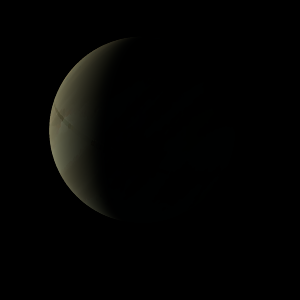| Fictional info (?) |
|---|
| Suggested name | Suchi-ze |
| Planet type | Terrestrial |
| Having almost no atmosphere to retain heat, it has surface temperatures that vary diurnally more than on any other planet in its solar system, ranging from 140°K (-133°C) at night to 1050°K (777°C) during the day across the equatorial regions.
The carbon dioxide has probably photodissociated, and the free methane has been swept into interplanetary space by the solar wind because of the lack of a planetary magnetic field.
Wind speeds can reach 135 metres per second.
Surface full of small advanced herbivores known to spend their life in caves by consuming the Tomonyu He. Kepikyo Ro are somewhat similar to the Guru'kotsu, have scales and vary in length from 26 to 57 mm. The Kepikyo Ro are known to reproduce at temperatures from -30 to 30°C and drought which is rare on this planet. |
| Estimated population | 29000000 |
| Atmosphere | Methane | 73% |
| Oxygen | 25% |
| Carbon dioxide | 0.83% |
| Water | 0.21% |
| Atmospheric pressure | 70 bar |
 |
| Moon | Zatekya-tokyogi | Very small round oceanic asteroid |
| Girya'tsu | Large potato shaped ice asteroid |
| Muhemo Kyame | Medium-sized irregular ice planetoid |
| Hyowo Go | Medium-sized potato shaped oceanic asteroid |
| Wabyu | Small round crater-filled moon |
| Nyamyo-mu | Very small potato shaped rocky moon |
| Giumaso Gohyashi | Large slightly egg-shaped crater-filled moon |
| Gyuko Bibyo-hyu | Huge potato shaped oceanic moon |
| Pyanyo | Huge potato shaped rocky moon |
| Hazuhyu'chi | Small almost round ice comet |
| Ryazu Pushu | Medium-sized almost round crater-filled moon |
| Nehyaro | Medium-sized slightly egg-shaped ice asteroid |
| Kagikya | Medium-sized irregular ice asteroid |
| Jishu Opene Pi | Medium-sized potato shaped crater-filled moon |
| Puberyo-wa | Small round oceanic asteroid |
| Buchu | Large round ice moon |
| Hyoa-shishu-byu | Large potato shaped rocky moon |
| Yupi Ohya Cha | Small slightly egg-shaped crater-filled comet |
| Epamaso Bo | Large round ice moon |
| Byogyugya-ronra | Huge irregular oceanic planetoid |
| Chopu Doru | Large round ice asteroid |
| Nechize | Small potato shaped ice moon |
| Pape Jibu | Huge potato shaped rocky moon |
| Wacha'pyubyo Ge | Small round ice moon |
| Pochui Jamyashu | Huge potato shaped rocky asteroid |
| Munebyo-opogo Tsu | Very small round rocky comet |
| Pepunya Da | Medium-sized irregular oceanic moon |
| Roshopyo Yoegyu | Small almost round rocky moon |
| Moge Wato | Medium-sized irregular ice moon |
| Pubi-nmonu | Small irregular rocky planetoid |
| Google search for Suchi-ze |